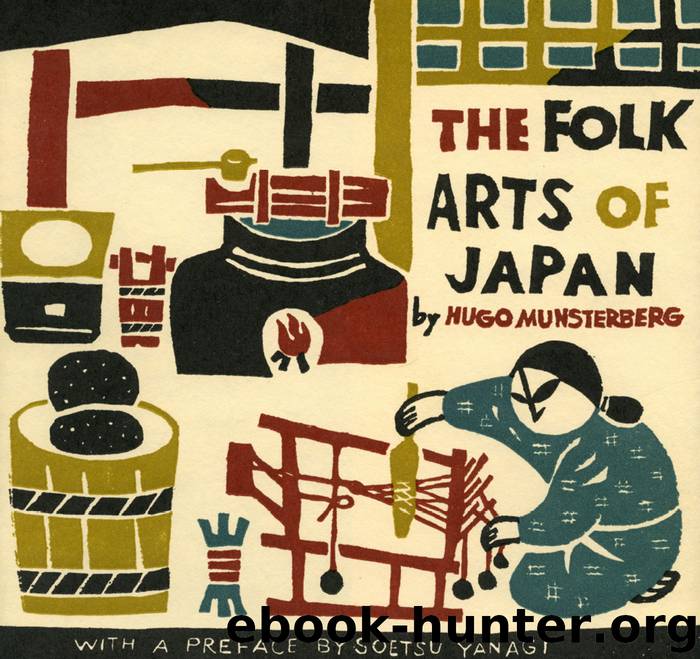Folk Arts of Japan by Hugo Munsterberg

Author:Hugo Munsterberg
Language: eng
Format: epub
ISBN: 978-1-4629-0887-5
Publisher: Tuttle Publishing
Plate 66. Daruma dolls, papier-mâché, from Gumma Prefecture (left) and Fukuoka Prefecture (right).
Plate 67. Girl Daruma, papier-mâché. Ehime Prefecture.
Plate 68. Tiger figurine, papier-mâché. Matsue, Shimane Prefecture.
Plate 69. Ox figurine, papier-mâché. Hanamachi, Iwate Prefecture.
Plate 70. Straw horse, wara-uma. Nagano Prefecture.
Of the many other kinds of toys produced in papier-mache, the ai-ai-gasa, dolls representing the lovers Junshin and Oshima, are probably the most famous. These dolls have their origin in a legend from Kochi, a town on the island of Shikoku, but the figures as well as the story behind them are well known throughout Japan. Junshin was a monk at the Chikurin-ji, a temple in Kochi, and fell in love with the beautiful Oshima. The two lovers disguised themselves and attempted to flee by night but were caught the next morning. They are represented carrying an umbrella and a lantern to light their way through the dark.
Color Plate 1, p. 21
Other popular dolls are the papier-mache figures of dancers. Those from Miharu, in the Tohoku region (Color Plate 1), are quite charming in the graceful lines of the kimono-clad girl and the delicate expression of her face. The subdued, fresh, light-blue tint of the upper garment and the warm brown of the kimono are enhanced by contrasting green patterns.
Download
This site does not store any files on its server. We only index and link to content provided by other sites. Please contact the content providers to delete copyright contents if any and email us, we'll remove relevant links or contents immediately.
The Art of Boudoir Photography: How to Create Stunning Photographs of Women by Christa Meola(18537)
Red Sparrow by Jason Matthews(5390)
Harry Potter 02 & The Chamber Of Secrets (Illustrated) by J.K. Rowling(3620)
In a Sunburned Country by Bill Bryson(3481)
Drawing Cutting Edge Anatomy by Christopher Hart(3453)
Figure Drawing for Artists by Steve Huston(3381)
Harry Potter and the Prisoner of Azkaban (Book 3) by J. K. Rowling(3304)
The Daily Stoic by Holiday Ryan & Hanselman Stephen(3230)
Japanese Design by Patricia J. Graham(3109)
The Roots of Romanticism (Second Edition) by Berlin Isaiah Hardy Henry Gray John(2878)
Make Comics Like the Pros by Greg Pak(2852)
Stacked Decks by The Rotenberg Collection(2811)
Draw-A-Saurus by James Silvani(2655)
Harry Potter and the Deathly Hallows (7) by J.K. Rowling(2640)
Tattoo Art by Doralba Picerno(2600)
On Photography by Susan Sontag(2575)
Churchill by Paul Johnson(2506)
The Daily Stoic by Ryan Holiday & Stephen Hanselman(2458)
Drawing and Painting Birds by Tim Wootton(2438)
